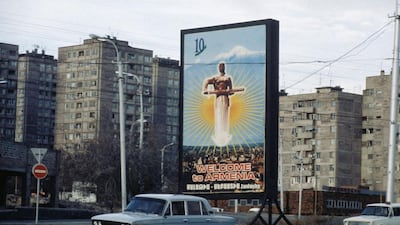Almost half a century ago, the Polish writer Ryszard Kapuscinski meandered through the back alleys of Yerevan where he happened upon the backyard of the sculptor Benik Petrosyan.
"The backyard, enclosed on four sides by the walls of apartment buildings, is the site of a permanent exhibition of Benik's works," writes Kapuscinski in Imperium, his 1993 classic of Soviet-era reportage. In his account, Kapuscinski describes the artist as "a remarkable talent".
It is possible today for visitors to Yerevan to retrace Kapuscinski’s footsteps, even if rapid development has changed the character of the old town.
For many Armenians, the changes to Yerevan’s urban landscape sit uneasily and, in June last year, many protested against a commercial plan to demolish the 130-year-old Afrikyan Clubhouse and to build a hotel in its place. One of the protesters demanded that authorities respect “a place of memory”.
Down the road from another construction site and a few blocks from where Benik’s outdoor exhibition stood in 1967, lives his daughter Arev. She, too, is an artist. She, too, is preoccupied with memory, although her focus is on her father’s legacy. Like her father, who died in 1996, Arev is a remarkable talent and is renowned as one of Armenia’s leading artists. (Her family is similarly gifted: one brother is a sculptor; another a jazz musician; her mother was a violinist.)
Family photos are scattered across Arev’s mantelpiece, but it is the various works of art that frame an eye-catching vignette. Spanning three generations, they also offer a snapshot of Armenian history. Arev’s work, a large red and yellow painting, acts as a backdrop to a framed abstract piece created by her teenage son and to several of Benik’s sculptures.
For Benik, who was born in 1939, the rawness of the genocide and Armenia’s incorporation into the Soviet empire loomed large over his life.
“Benik was a very lost person in Armenia, very lost in the Soviet Union,” says Arev. “But his art was not trying to be very painful, he was a little bit humorous and sarcastic.”
With pride she presents Benik’s sculpted metallic apple that opens up to show Adam and Eve at the rotten core.
“In his life, he gave about 700 sculptures,” says Arev. Yet as Kapuscinski reported, Benik’s works seldom found their way to exhibitions. Although a temporary exhibition was held at the Armenian Artists’ Union in 2010 to celebrate the 70th anniversary of Benik’s birth, Armenia has done little to honour his works, despite the diaspora minister, Hranush Hakobyan, saying at the time that the artist’s “creations must be preserved”.
The Armenian National Gallery, a sturdy building guarding Yerevan’s Republic Square, is home to works by Donatello, Rubens, Kandinsky, et al. It lists Benik’s work in its catalogue, yet none is on display. The gallery itself is stuffy and worse for wear.
President Serzh Sarkisian, in power since 2008, has to contend with other concerns. Anti-government protests are frequent on Republic Square, the most notable of which took place in October last year, when 10,000 people raised their voices against endemic poverty and entrenched government corruption.
Sarkisian’s government joined the Russian-led Eurasian Economic Union in 2014, even though the legacy of the Soviet era stirs the emotions of many younger Armenians who fear Russia’s influence and would prefer that their country looks westwards.
Kapuscinski, though, lists Persia, Turkey, the Arabian caliphate, and Byzantium as other “political colossi, ambitious, expansionist, fanatical, voracious” that threatened Armenia through the ages.
“The source of all of Armenia’s misfortunes was its disastrous geographic location,” he argues.
Sitting atop a hill over Yerevan is the Matenadaran. Opened in 1959, it is an austere and solemn building – a symbol of Armenia’s defiance and resilience in the face of the imperium Kapuscinski studied.
The Matenadaran is the repository of Armenia’s history, of its ancient manuscripts. As a state constantly under threat, theorised Kapuscinski, Armenians sought “salvation in symbols”. The manuscripts, written in an alphabet first devised in 405AD, are the manifestation of the Armenian desire to protect their identity.
However, the resplendent gilded manuscripts track not only Armenian history, but also that of the world. The Armenians translated Greek and Roman philosophers and then the works of the Arab, Persian, Turkish and Byzantine invaders.
Kapuscinski, who died in 2007, tells us that the Matenadaran is for an Armenian “the end of his pilgrimage”. Gregorio, a diaspora Armenian from Argentina, is one such pilgrim, visiting his homeland for the first time.
“Being in Armenia is weird, emotional,” he says. “My grandmother, before she died, asked me to visit Armenia.” She was 94 when she died, filled with hatred for the Turks, he adds, although as the genocide centennial approaches, he is at a loss to understand her loathing.
Like many Armenians, he will leave Armenia, perhaps never to return. Yet the Matenadaran will stand and protect its invaluable trove of intellectualism for posterity.
Despite a long history of preservation, Armenia’s failure to honour the legacy of Benik, and the destruction of much of Yerevan’s architectural heritage, strike at the heart of a contradiction in post-Soviet Armenia.
Arev takes inspiration from the ancient Armenian alphabet and the Matenadaran’s gold-and-blue-hued manuscripts. In March she announced that she would open a gallery to preserve and display Benik’s work.
This might resonate with Kapuscinski. “The protection of the symbol is an act of patriotism,” he writes.
Richard Ferraris is a senior editor at the Delma Institute in Abu Dhabi.
thereview@thenational.ae

